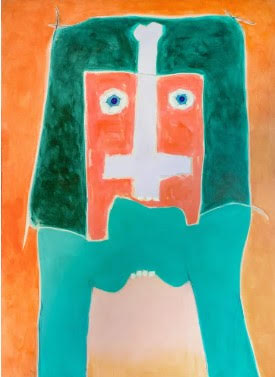The Savagery of Time Gets Its Due in David Hare’s Surrealist Take on the Mythological Cronus
The works are replete with ominous, devouring looking figures paired with embryonic, gestating forms.

‘David Hare: The Cronus Series’
Lincoln Glenn Gallery, 524 West 24th Street, New York, New York
Through July 27, 2024
David Hare represents a curious inflection point in the history of surrealism. A movement generally associated with the Parisian artists of the 1920s and 1930s, Hare, who was originally a photographer, began painting from the 1950s onward. While his fellow painters of the New York school caught the wave of abstract expressionism, however, he stayed devoted to the movement. As such, he represented an anomaly in late 20th century painting, working steadily on in his idiom while his contemporaries moved forward.
The series, at Lincoln Glenn’s snug West 24th Street address, features work from his Cronus series, and stretches from 1967-1990. Following in the surrealist tradition with its deep engagement with the literary, the psychoanalytic, and the mythological, the series does not disappoint.
The theme of Cronus, or the mythological figure of time, runs through the show as both a destructive and generative force. The works are replete with ominous, devouring looking figures paired with embryonic, gestating forms.
At first glance, we can see echoes of Paul Klee, who is occasionally grouped with the surrealists as well. Along with both artists’ devotion to mythological themes, there is also a strong attention to shape, line, and color, a level of modernist sophistication and subtlety.
Unlike Klee, who preferred to keep his art exquisitely mandarin, Hare is not afraid of being dark, however. This is Cronus, after all, relentless devourer of all, whose myth is replete with cannibalism, castration, and filicide. In this series he appears as a gaping maw, an orangey red fire, or reptilian predator, lying in wait. The savagery of time gets its due.
Any treatment of Cronus in a painting can’t fail to reference Francisco Goya’s horrific masterpiece “Cronus Devouring his Children,” and that is abundantly evident here. “Cronus Elephant,” painted in 1975, has the same staring eyes and gnashing teeth as Goya’s original. Yet it is also abstracted to the point it includes all manner of semi-hidden erotic and animalistic elements.

The face could be an elephant sporting its trunk, but it could also, as Hare himself pointed out, be an erect phallus, while the teal jaws could also be the elephants’ legs. Hare cleaves to the surrealist credo of making forms stand for amorphous, ambiguous, and at times self-contradictory symbols. Set in its field of orange and rose, it is also strangely calm if not mediterranean in feel. Another layer of contradiction.
That appears to be Hare’s point in his relentless excavation of the theme of time, as he devoted more than two hundred works to it. Time gives rise to life, blossoming, sexuality, all things vital, and time erodes, devours, erases, and decays. Yet it is also invisible, operating relentlessly in the background.
It is the paradox of paradoxes in other words. Cronus descending uses the same compositional elements to create a figure that is almost war-like in its ferocity, the devouring mouth and eyes flanked by what appear to be large blood orange arms.
“Cronus Asleep in the Cave” seems more addressed to the nascent aspects of time. A supine pink form on a sienna background appears to be a sleeping figure, with a tiny shape, perhaps a limb, extending upwards. It might be the tiny arm of Zeus’s siblings escaping. A ball, possibly an embryo or a sun, gestates redly inside the pink figure.
On close examination, the pink is marvelously patinated, almost roseate and fleshy in tone, and you notice that the background is divided into three bands of darker or lighter ochre. The formalist elements, once again, set off the pictorial ambiguity, which once again amplify the mythological elements. Mythology is a murky, dreamlike business, and Hare seems to strike a knife edged balance between modernist compositional elements and its dream-like underpinnings.
Another example is “Cronus (dining at night),” which resembles a giant nearly occluding the horizon. It has marvelous, weighty feet that anchor the figure at the bottom, which then disappear into pillars of smoke and a possible breath of fire. Two large eyes at the top appear to be staring.
Once again he appears to be referencing the devouring, horrible stare of Goya’s Cronus, the eyes of a metaphysical force stuffing its gullet. Yet his use of color, a touch of cerulean at the top and gracing the feet, adds a touch of serenity, anchored as it is against an inky black background.
While Hare, who died in 1992, was recognized with a retrospective at the Guggenheim in 1977, he has yet to fully receive his due. As an outsider belonging to the first-generation painters of the New York School, he was an enigmatic figure to place historically. Thus we are fortunate that the assiduous lovers of 20th century painting at Lincoln Glenn were able to unearth these rare works from Hare’s opus.

